Crossref Citations
This article has been cited by the following publications. This list is generated based on data provided by Crossref.
Gorter, J. W.
Stewart, D.
Cohen, E.
Hlyva, O.
Morrison, A.
Galuppi, B.
Nguyen, T.
Amaria, K.
Punthakee, Z.
Arora, S.
Brill, H.
Cairney, J.
Don-Wauchope, A.
Grant, C.
Nagel, K.
Rosenbaum, P.
Kim, H.-J.
Lacombe-Duncan, A.
and
Weiser, N.
2015.
Are two youth-focused interventions sufficient to empower youth with chronic health conditions in their transition to adult healthcare: a mixed-methods longitudinal prospective cohort study.
BMJ Open,
Vol. 5,
Issue. 5,
p.
e007553.
Alsem, M. W.
Verhoef, M.
Gorter, J. W.
Langezaal, L. C. M.
Visser‐Meily, J. M. A.
and
Ketelaar, M.
2016.
Parents' perceptions of the services provided to children with cerebral palsy in the transition from preschool rehabilitation to school‐based services.
Child: Care, Health and Development,
Vol. 42,
Issue. 4,
p.
455.
Mcphee, Patrick G
Claridge, Everett A
Noorduyn, Stephen G
and
Gorter, Jan Willem
2019.
Cardiovascular disease and related risk factors in adults with cerebral palsy: a systematic review.
Developmental Medicine & Child Neurology,
Vol. 61,
Issue. 8,
p.
915.
Bonanno, Marco
Desjardins, Leandra
Lugasi, Tziona
Carrier, Julie
Labonté, Nathalie
Sultan, Serge
Coltin, Hallie
Perrault, Sébastien
Provost, Carole
Laverdière, Caroline
Cloutier, Nancy
Saragosti, Andrea
Régnier-Trudeau, Émilie
and
Koukoui, Benedicte
2024.
Protocol for evaluation of the feasibility and preliminary efficacy of a targeted transition readiness workshop intervention for pediatric brain tumor survivors.
Pilot and Feasibility Studies,
Vol. 10,
Issue. 1,





